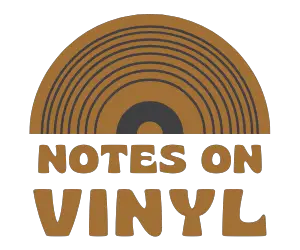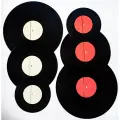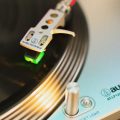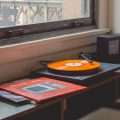Are you new to all this audiophilia business? Want to get a straight answer to the pertinent question of “What are turntables?” Are they the same as record players?
All this and more today as we explore the ins and outs of the turntable form, running through some of the key components as well as what to look for when buying your very own.
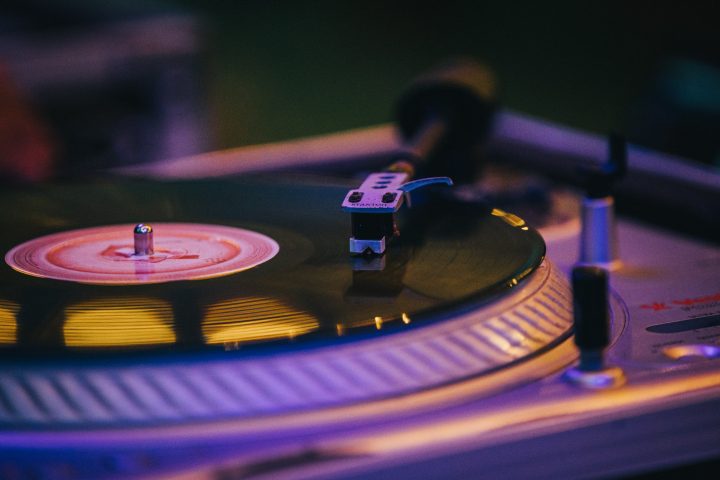
Table of Contents
- What Is a Turntable?
- History of Turntables
- Record Player vs Turntable
- Parts of a Turntable
- Types of Turntables
- How Turntables Work
- How to Choose a Turntable
- Care and Maintenance
- Final Tones
- FAQs What Are Turntables?
What Is a Turntable?
A turntable is, in essence, part of a stereo system, the part that deals with the rotation of vinyl records. Upon these records and written within the grooves is sensitive vibrational data that, once interpreted by the turntable’s cartridge, will be emitted forth as music.
Needless to say, this is a delicate process, so it is no wonder that turntables can fetch such high sums – the best turntables under $2000 might be expensive, but really are the cream of the crop. The less expensive a turntable, the less emphasis will be placed on the sound quality.
The process of operating a turntable will typically go like so:
- Choosing a record and placing it on the platter
- Picking up the stylus and placing it on the edge of the record (something that is automated in automatic turntables).
- Letting the turntable do its magic.
If you are lucky enough to have a high-end turntable, then you will, fortunately, be presented with a superior sound quality when you play music in this way. A higher quality sound will be a result of superior components and perhaps a little more attention to detail and care paid to the turntable in the process of manufacture.
History of Turntables
From Phonographs to Modern Turntables
Turntables, also known as record players, have a rich history that dates back to the late 19th century. It all started with the invention of the phonograph by the legendary Thomas Edison in 1877. This groundbreaking device used wax cylinders to record and play back sound, revolutionizing the way people experienced music.
As technology progressed, the gramophone emerged, using flat discs instead of cylinders. These discs, made of shellac and later vinyl, became the standard format for recording and playing music. The turntable, as we know it today, evolved from these early innovations.
The Rise of Vinyl Records
In the 1940s and 1950s, vinyl records became increasingly popular, and the turntable became a staple in households across America. The introduction of the LP (long-playing) record in 1948 allowed for longer recordings and better sound quality, further cementing the turntable’s place in music history.
Throughout the decades, turntables continued to evolve, with manufacturers introducing new features and improvements. Stereo sound, direct-drive motors, and advanced cartridges all contributed to the enhanced listening experience that music enthusiasts craved.
The Digital Age and the Resurgence of Turntables
With the advent of digital music formats like CDs and MP3s, many thought that turntables would become obsolete. However, a renewed appreciation for the warm, analog sound of vinyl has led to a resurgence in the popularity of turntables in recent years.
Vinyl sales have been steadily increasing, and turntables are once again finding their way into the homes of music lovers young and old. The tactile experience of handling a record, the ritual of placing it on the platter, and the unmistakable sound of the needle dropping onto the vinyl all contribute to the enduring appeal of turntables.
Today, turntables come in a variety of styles and price points, from entry-level models perfect for beginners to high-end audiophile setups that offer unparalleled sound quality. Whether you’re a seasoned collector or a curious newcomer, the history of turntables is a fascinating journey through the evolution of music playback technology.
Record Player vs Turntable
So now that you have an answer about what are turntables, it is time to learn the difference between a turntable and a record player. Often the terms are used interchangeably, so it can be difficult to know the difference between a turntable vs a record player.
Many are perfectly happy to use the terms turntable and record player in this way, and that is perfectly fine for them. But if you are trying to have a conversation with an audiophile or otherwise get to the bottom of something that is troubling your listening experience, then specificity is everything.
So, if turntables spin the disc itself, what do record players do? Well, funnily enough, record players do it all and then some.
Record players are, in fact, the entire stereo system in one. The term technically refers to all-in-one record players, a format especially popular in this age of backward-looking nostalgia for the sake of it. This is what the average Crosley and Victrola is, a single unit containing all the different components necessary to play the record.
This includes the turntable, the stereo amplifier, the preamp, the speakers, etc.
This is, of course, not to say that you can’t outsource the audio to some external speakers – in fact, we would encourage this greatly, especially if you are rocking a Crosley vs Victrola. Rather, this term simply comes to describe a self-sufficient unit that can entirely reproduce audio from records without any extra accessories.
Seeing as a turntable is part of this island of self-sufficiency, we can safely assume that the turntable is in need of other components in order to function.
Interestingly enough, you can still play music with just a turntable and a record. The vibrations in the grooves will emit through the stylus, albeit very, very quietly. They just won’t be sent through the cartridge and amplified. This is why you can play music with a £5 note in the UK, where the paper currency is made from a plastic polymer that is more difficult to destroy or deface.
Parts of a Turntable
Now, there are far more substantial studies into the parts of a turntable on this website, but suffice it to say that it is necessary to summarize them briefly here.
Platter
This is the part of the turntable that does the spinning itself. For this reason, it is one of the few parts of a turntable and a stereo as a whole that actually comes into contact with the disc itself.
Thus, it is of the utmost importance, and yet it is very often neglected in favor of many other elements.
If you are really wanting to look after your records, you might want to invest in a slipmat. Though the one that the platter comes installed with will usually suffice, you can never be too sure. This is also a great opportunity to customize your noble steed.
Spindle
This is another part of the equation that is often neglected to the point that many do not even know its name.
Go on, have a guess. What even is a spindle?
The scholarly amongst you will have surmised that it is the very center of the turntable, the pike through which the hole in the record is threaded so that it does not wander off course.
This is obviously of the utmost importance. Everyone who has tried to play 7-inch vinyl record types without one of the centerpieces will know just how prone records are to veering away from their intended path.
Tonearm
Here we have one of the more obvious parts of the turntable. Once the eye has digested the main body of it, chances are that it will soon drift to the phallic appendage sticking out on either the left or right side.
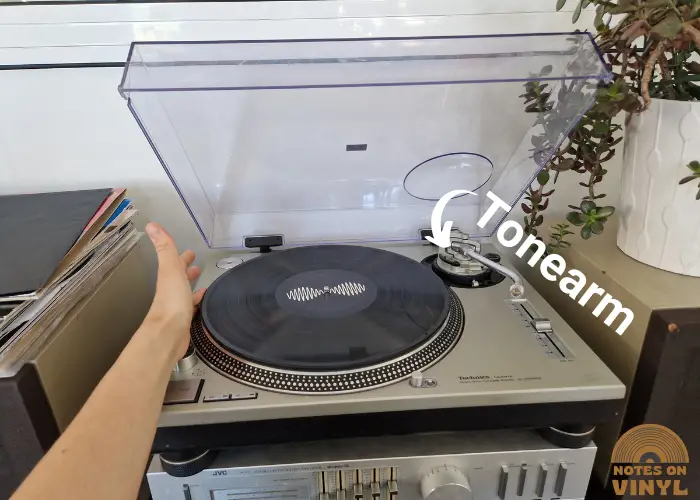
This appendage is known as the tonearm and is responsible for holding the cartridge and stylus and, thus, acting as a messenger between these components and the preamp.
Obviously very important, and it should not be difficult to see how a faulty tonearm could entirely ruin a turntable’s ability to playback properly.
Cartridge
At the very end of the tonearm, almost as though crowning it, is the cartridge itself. The cartridge houses the stylus, though its uses are not strictly limited to simply acting as a vessel for it.
Rather, it interprets the signals the stylus absorbs from the record and converts them into electrical signals that can then be reinterpreted by the preamp and then the amplifier.
Think of the cartridge as an interpreter that might operate at the side of a head of state when they are meeting another head of state from a different continent.
Prices pulled from the Amazon Product Advertising API on:
Product prices and availability are accurate as of the date/time indicated and are subject to change. Any price and availability information displayed on [relevant Amazon Site(s), as applicable] at the time of purchase will apply to the purchase of this product.
Stylus
As already hinted at, the stylus and the cartridge make a perfect pair. While the cartridge is tasked with reinterpreting the stylus’s signals after the fact so that they are able to be passed onto the preamp and amplifier, the stylus is on the front line.
This makes the stylus one of the other few parts that actually come into contact with the disc itself. The stylus’s job is perhaps the most crucial of those that come into direct contact with the record as it is receiving the vibrational data imbibed within the grooves and rendering it usable. Without it, there would be no music whatsoever.
Preamp
So, once the grooves have been read by the stylus and this initial signal has been translated by the cartridge, it is then sent forth through the tonearm and onto the preamp for the turntable.
It is then the job of the preamp to boost the signal so that it can then be sent to the amplifier.
Why can the amplifier not just do the job itself? Well, this initial signal is very weak and so requires two stages of amplification, lest it comes out all distorted and unrepresentative of the record at the base.
Many stand-alone turntables that are manufactured today come with preamps built in, though this is not always the case.
Amplifier
Though the amplifier is not usually part of a turntable, it is still worth noting here, especially since it is the end stage of the process we have been detailing here.
Once the preamp has done its work, then the sound waves are ready to be sent forth to the amplifier, which will then send the sound through a pair of speakers that are attached.
- Amplify and enjoy your home audio experience in the comfort of your home.Frequency band : 2,400 MHz – 2,483.5 MHz, Maximum output power : ≤ 5.0 dBm..Connector Type: Bluetooth
Prices pulled from the Amazon Product Advertising API on:
Product prices and availability are accurate as of the date/time indicated and are subject to change. Any price and availability information displayed on [relevant Amazon Site(s), as applicable] at the time of purchase will apply to the purchase of this product.
Remember, in a record player, all of these components operate as one, hence why they can sometimes be so heavy.
Types of Turntables
When it comes to turntables, you’ve got options – and we’re not just talking about colors and styles. The way your turntable spins that beloved vinyl can make a big difference in sound quality and overall performance. Let’s dive into the three main types of turntables: belt drive, direct drive, and idler wheel.
Belt Drive: The Smooth Operator
Belt drive turntables are like the gentle giants of the vinyl world. They use an elastic belt to connect the motor to the platter, which helps isolate the platter from the motor’s vibrations. This results in a smoother, quieter operation, reducing the chance of any unwanted noise making its way into your music.
One downside? Belt drive turntables can take a bit longer to get up to speed, and the belt may need occasional replacing. But for many audiophiles, the trade-off is worth it for that silky-smooth sound.
Direct Drive: The DJ’s Choice
If you’ve ever seen a DJ spinning records at a club, chances are they were using a direct drive turntable. In this design, the motor is directly connected to the platter, offering more torque and quicker start-up times. This makes direct drive turntables ideal for DJ techniques like scratching and back-cueing.
The downside of direct drive? Because the motor is so close to the platter, there’s a higher chance of motor noise being picked up by the stylus. However, high-end direct drive turntables often have advanced motor designs that minimize this issue.
Idler Wheel: The Vintage Vibe
Idler wheel turntables are like the classic cars of the audio world – they’re not as common these days, but they’ve got a certain charm. In this design, a rubber wheel sits between the motor and the platter, driving the platter’s rotation.
While idler wheel turntables offer quick start-up times and strong torque, they’re also more susceptible to noise and vibration issues. Plus, the rubber wheel can wear out over time, affecting speed consistency.
How Turntables Work
Ever wonder what’s going on under the hood of your trusty turntable? Let’s take a closer look at the magic that happens when you drop the needle on your favorite record.
The Platter Spins the Tale
At the heart of every turntable is the platter, the circular platform that spins your vinyl at just the right speed. Most turntables offer two speeds: 33 1/3 RPM for your standard LPs and 45 RPM for those classic singles and EPs. The platter’s steady, unwavering rotation is crucial for delivering that smooth, consistent sound we all crave.
The Motor: Powering the Groove
But what keeps the platter spinning like a well-oiled machine? That’s where the motor comes in. Belt-drive turntables use an elastic belt to connect the motor to the platter, which helps isolate the platter from the motor’s vibrations. Direct-drive turntables, on the other hand, have the motor directly connected to the platter, offering more torque and quicker start-up times.
The Tonearm and Cartridge: Dynamic Duo
Now, let’s talk about the tonearm – that sleek, pivoting arm that gently guides the cartridge across your record’s surface. The cartridge, mounted on the end of the tonearm, is where the real magic happens. Inside the cartridge, you’ll find the stylus, or needle, which rides along the record’s grooves, picking up those tiny vibrations and converting them into electrical signals.
The Stylus: Tracing the Groove
As the stylus traces the record’s grooves, it vibrates, and those vibrations are transmitted to the cartridge’s internal components. Moving magnet (MM) cartridges use a tiny magnet attached to the stylus, which moves within a coil of wire to generate the electrical signal. Moving coil (MC) cartridges have a coil of wire attached to the stylus, which moves within a magnetic field to produce the signal.
From Signal to Sound
The electrical signal generated by the cartridge is then sent through the tonearm wires to the turntable’s output jacks. From there, the signal travels to your phono preamp, which amplifies the signal and applies the necessary RIAA equalization curve. Finally, the signal is sent to your main amplifier and speakers, where it’s transformed into the warm, analog sound that vinyl lovers can’t get enough of.
How to Choose a Turntable
So, now you know what are turntables and the difference between a turntable and a record player, it might be a good time to start thinking about what you might want to consider when you are looking to buy one.
Operation
No, not the board game, silly! When we refer to operation we are talking about the level of automation inherent in the turntable.
Though there are more variants of turntables than ever before (thanks to the vinyl revival), there are three main types, at least in terms of automation.
The automatic turntable is a turntable that automates both the placing of the needle onto the disc and the removal of the needle once the record has finished. It is thus that they are often called upon to cater to newer turntable users.
The manual turntable is a turntable positioned on the opposite end, whose functions are in no way automated and that, therefore, require the involvement of the user in removing and placing the needle onto the record.
The semi-automatic turntable strikes a healthy balance between the two, either automating the placing of the needle onto the record or the removal of it once the disc has finished, though never both. This makes it an apt choice for those who are somewhat experienced with audiophilia and want to branch out.
Wow and Flutter
Though not entirely necessary to know when purchasing a turntable, these terms will come in handy later down the lane if you intend to fix your turntable when it stops working as intended.
The turntable should spin at a more or less consistent speed, though this can be jeopardized in a home environment where things are constantly being plugged in and unplugged. Such actions disturb the sanctity of the power supply in a house, causing it to flow in tributaries that run contrary to the stability that a turntable needs.
This is simply an unavoidable part of the process, sadly, and something that many an audiophile has been kept up at night thinking about. However, some turntables can cope with it better than others. So, in looking for your own turntable, you will want to ask the salesperson how well it deals with these kinds of fluctuations of current.
If wow and flutter refer to a turntable being unable to play consistently at a constant speed, how willing would you be to put up with it?
Drive
That is not an order unless it is an order to invest some time in researching the drives in turntables.
Again, despite there being more variants than ever before, turntables are remarkably easy to categorize if you have the right understanding.
In terms of motors, most sit somewhere in the dichotomy between direct drive vs belt drive turntables. This issue has been covered in greater detail elsewhere on this site (link above), but it is necessary for the purposes of cohesion to do so again here, however briefly.
Belt drive turntables are run by attaching a rubber belt to a motor. This motor chugs along and pulls the turntable platter with the belt threaded through it. This causes the platter to spin. While there is inherently more wow and flutter with such turntables, you can also be sure that it will not be too noisy.
Direct drive turntables, on the other hand, are powered by magnets, meaning there is no contact between the motor and the platter. While these kinds of turntables can stop and start much faster, the fact that the motor is so close to the platter means that its noise is more likely to get picked up.
Cartridge
The quality of the cartridge is arguably the most important factor in purchasing a turntable, at least in terms of the quality of the sound played back.
This is one of the main reasons why many audiophiles will encourage users of Crosleys and Victrolas to purchase separate cartridges and install them onto the record player. While the cartridges that are fitted in the factory are borderline criminal, the record players themselves are not so bad, so long as they are fitted with something else on the tonearm’s tip.
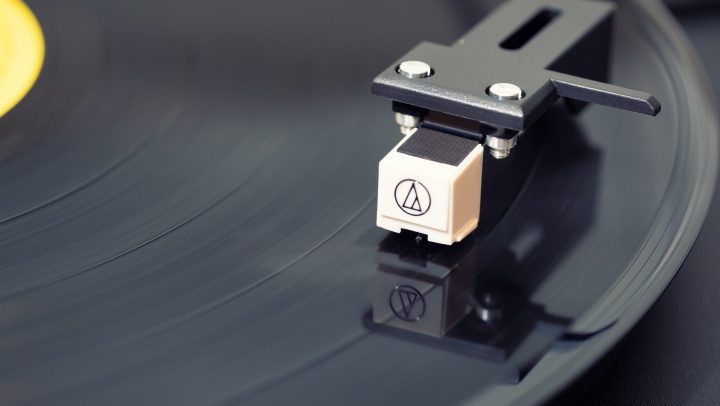
However, once you pass the $250 mark, then the differences are rather minute. At this point, you would only really be investing the money if you were extremely interested in the kind of tonal characteristics that they had to offer.
Anything by Audio-Technica will do the trick. Even their cheapest models are well worth an investment of your time. Ortofon is also a very good brand. There are more and more mid-range turntables released today that come fitted with an Ortofon from the factory – these are definitely worth going for if you have the cash.
Tracking Force
Even if it does not necessarily factor into your purchasing of a turntable, it pays to know about tracking force, for it could very easily save you a bunch of money in the long term.
Plenty of audiophiles would suggest that the sooner you clue into it, the better. It is deemed important by such audiophiles to invest in a turntable that has a counterweight on the tonearm.
While a tonearm is perfectly capable of getting the job done, sometimes it might over-exert itself and press a little too hard on the record’s surface. These kinds of micro-aggressions are not immediately obvious but will ever so slowly deteriorate the record at a far faster rate than a record might otherwise deteriorate.
Thus, a counterweight allows you to adjust the weight that the tonearm is impressing upon the disc, adjusting the force of the tonearm’s tracking, so to speak. If a tonearm acts too heavily on a record, it can damage the record’s grooves over time, but if it works too lightly, then the sound quality will be worse in the short term, and the tonearm is more susceptible to skipping.
Rumble
You will know that a turntable salesperson/manufacturer is really worth their salt in the industry if their products also include a rumble rating.
A rumble rating is a way to measure and refer to a turntable’s inherent ability to withstand vibrations. Certainly, each turntable is different, even if it is the same model, though a generalized rumble rating for a certain series of turntables will give you something of an idea.
The industry standard suggests that you invest in a turntable with a minimum rumble rating between -40 and -50.
Perhaps this mode of measurement seems a little confusing. That is because it is. In this area, higher measurements are actually worse in terms of the amount of rumble they can withstand. Thus a measurement with, say, a -80 rating will fair much better in terms of its ability to fend off pesky external vibrations.
A turntable’s rumble rating tends to run parallel to its weight. Turntables with heavy bodies are almost certainly going to have higher rumble ratings. Their heavier bodies will inherently fend off or absorb external vibrations better than a plastic body might, for example.
Care and Maintenance
Your turntable is more than just a piece of audio equipment – it’s a trusted companion on your musical journey. And like any good friend, it deserves a little TLC to keep it spinning smoothly for years to come. Here are some tips for keeping your turntable in tip-top shape.
Keep It Clean
Dust and dirt are the sworn enemies of any turntable. They can accumulate on the stylus, causing sound quality to suffer and potentially damaging your precious records. To combat this, make sure to use a stylus cleaner regularly. These handy little tools gently brush away any debris from the stylus tip, ensuring clean and clear sound.
But don’t stop there – your records need love too! Invest in a good record cleaning kit, complete with a soft brush and cleaning solution. Give your vinyl a gentle sweep before and after each play to keep them free of dust and static.
- 💿 ULTIMATE VINYL RECORD CLEANING KIT: This 5-in-one record cleaning kit includes all the benchmark essentials for a spotless and rich sounding collection. In this kit, you will receive (1) Velvet Brush (1) Microfiber Brush (1) Stylus Brush (1) bottle of Cleaning Solution and (1) handy Storage Pouch. With these tools, you’ll be able to tackle any cleaning session with ease and perfection.
Prices pulled from the Amazon Product Advertising API on:
Product prices and availability are accurate as of the date/time indicated and are subject to change. Any price and availability information displayed on [relevant Amazon Site(s), as applicable] at the time of purchase will apply to the purchase of this product.
Cover Up
When your turntable’s not in use, keep it protected with a dust cover. This simple addition can make a world of difference in keeping your gear clean and scratch-free. Plus, it adds a sleek, finished look to your setup.
If your turntable doesn’t come with a dust cover, consider purchasing one separately. They come in a variety of sizes and styles to fit any setup.
- ECONOMIC FABRIC: Made of durable quilted nylon and the interior is lined. Machine washable, easy care jacket, waterproof feature, keeping it from dust, oil, coffee, milk, kitchen vapour, lampblack, haze dirt and urine, cat pee, fluffy hair, pet hurt
Prices pulled from the Amazon Product Advertising API on:
Product prices and availability are accurate as of the date/time indicated and are subject to change. Any price and availability information displayed on [relevant Amazon Site(s), as applicable] at the time of purchase will apply to the purchase of this product.
Level Up
A level turntable is a happy turntable. If your platter isn’t spinning on an even plane, it can lead to all sorts of issues – from uneven wear on your records to distorted sound.
Most turntables come with adjustable feet, allowing you to fine-tune the level. Use a spirit level (you can even use a smartphone app in a pinch) to ensure your turntable is perfectly flat. It’s a small step that can make a big difference in sound quality.
Store Smart
When it comes to storing your records, think vertical. Stacking records horizontally can lead to warping and damage over time. Invest in some sturdy, upright record shelves to keep your collection organized and in mint condition.
And when you’re pulling out a record to play, always handle it by the edges. Touching the surface can transfer oils from your fingers, attracting dust and potentially damaging the grooves.
Know When to Seek Help
Sometimes, despite your best efforts, your turntable may need a little extra attention. If you notice any strange noises, skipping, or other issues, it may be time to consult a professional.
A qualified turntable technician can diagnose and fix any problems, from replacing a worn-out stylus to adjusting the tonearm balance. They can also give your turntable a thorough cleaning and tune-up, ensuring it’s running at its best.
Final Tones
So, there you have it! Hopefully, you are feeling a little more clued in knowing what are turntables and are able to discern the difference between turntables and record players. If you have any more questions or queries relating to turntables, whether about purchasing your own or something else, do not hesitate to leave a comment below.
FAQs What Are Turntables?
What are turntables used for?
Sometimes a turntable can serve as part of an entire record player, as in all-in-one record players, though often, when we think of turntables, we think of them as a separate entity. The turntable will feature a platter, cartridge, tonearm, stylus, and all sorts of inner mechanisms that ensure that the platter spins at a more or less consistent speed. Many modern turntables even contain their own preamp, invalidating the need to buy one separately.
Do turntables play vinyl records?
Indeed they do. Turntables are explicitly designed to play vinyl records. Of course, they are not the only part of a record player or stereo system, and so they technically can’t play vinyl records on their own. However, the stereo system would be useless without a turntable. The turntable is the part of the system that comes into direct contact with the vinyl record disc – the disc is placed on the platter, which is tasked with spinning at a more or less consistent speed, and the stylus is placed on the record to absorb and pass on all of the vibrational goodness locked in the grooves.
Why are turntables so popular?
I suppose a better question – and the question that this question is really asking – would be “Why are turntables so popular now?” Once upon a time, everyone listened to music in this way. Certain advances in recording technology rendered this format null and void for a time. All of a sudden, though, it has had a revival of interest and is actually thriving. Why is that? There are plenty of answers, though my own personal belief is that it is an extension of the climate of nostalgia that has infected the whole of the western world in the 21st century.
Do turntables play music?
Indeed they do, though they are not the only part of the stereo system, and thus they cannot play music on their own. Instead, they need an amplifier, preamp, and a set of speakers to get the show on the road. The turntable’s job is solely to spin the disc and then for its stylus to read and send forth the vibrational data written within the grooves. Compared to a disc drive, which can read DVDs, Blurays, and CDs, its uses are altogether rather limited.
